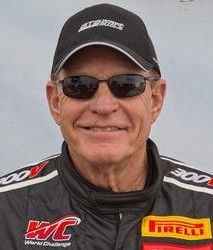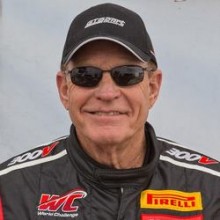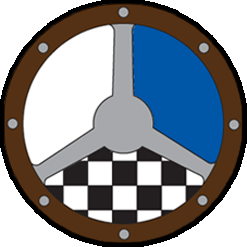Ask a pro
Receive advice directly from today’s top stars
Jack Baldwin, who has won five championships and competed in well over 500 professional road races in a career spanning more than four decades, is the latest Online Driving Instructor. Questions can be posted all this week. Check back after Monday, March 24 for his answers.


Jack Baldwin
Multiple championship-winning road racer
Born in Tampa, Fla., Jack Baldwin began his competitive career as a teenager on local drag strips before setting his sights on a career in road racing. In 1970 he jumped on the band-wagon that was Formula Ford, which over the years provided a launching pad for literally hundreds of top-line drivers, winning four SCCA Southeastern Division Championships as well as the coveted National Championship in 1972.
Baldwin started his first Trans-Am race as a co-driver in 1973, then worked as an instructor training Georgia State highway patrolmen at Road Atlanta before establishing a successful concert t-shirt business to help finance his career.
He won the Rolex 24 At Daytona in 1984 and went on to claim two consecutive IMSA GTU Championships in a Mazda RX-7. Highlights since then have included the 1992 SCCA Trans-Am Championship, during which he completed every lap of every race; two victories in the Twelve Hours of Sebring; a pair of second-place finishes in the prestigious International Race of Champions (IROC) series; and a fourth-place finish in a NASCAR Nationwide Series race at Watkins Glen in 1999. More recently he has proven that age is no barrier to success by emerging as a front-runner in the Pirelli World Challenge. Baldwin finished third in the intensely competitive GTS division in 2012 and second last year, driving a GTSport Porsche Cayman S with which he won three races and led the championship until narrowly losing out at the final round.
Jack Baldwin answers your questions!
-
Mike Harney
What did you take away from racing with ( and beating) legends like Dale Earnhardt in the IROC series?




Racing in IROC was my biggest honor by far. Just being out there with those great drivers was the thrill of my racing life. Dale (Earnhardt) is not only the driver I admire most, he was a friend. Dale was an amazing man among men and I learned a lot from with him on and off the track. Dale brought out the best that I had on the ovals, and being anywhere in front of him was an honor on any given lap. We had amazing battles at Darlington and Talladega and I don’t know who was happier after the race when he jumped out of his car and came to tell me what a great race it was. I was in awe! Honestly, I learned so much from staying pinned to his bumper. All the drivers in IROC were great but Dale was special, Dale was the best and you could see it plainly every race. His memory is still strong and I think about him often. When people used to say I was the Dale Earnhardt of Trans-Am, to me it was the ultimate compliment. I hope my driving style still reminds people of Dale. What did I learn? I learned that if I could have gotten a chance in NASCAR at a younger age, I could have made it because IROC proved I had a natural ability for stock car racing. To me it was like a duck to water, I loved it. Thanks for your question!
-
Anderson Rodrigues
I’m a driver in virtual racing. I have a team in partnership with a friend and we run a Brazilian league, with the simulator rFactor, in the GP2 Series cars, i.e. open-wheel cars. We are learning to do setups for the cars, but we have difficulty in solving a specific problem — uneven tire wear. In the last race we did in Melbourne, consumption of the left front tire was much higher than the rest of the tires. Hardening the suspension of the left-front tire had no positive effect, and hardening the right-front tire also did not have satisfactory results. What we could do to solve this specific case? Thank you for your help. I used Google translate to send you this message.




It’s pushing (understeering) and you are using too much left-front as you can see. Fixing it could be more than one change away but making if stiffer is generally not the way to go. I would take it to the setup pad and take a look at what you have and that will probably give you your answer.
-
Kevin Kibler
Do you remember what band or bands were on the first T-shirt you printed?




Aerosmith. I was the first person to print the Aerosmith wings in silver on a black shirt. Yep, I knew the boys back in the beginning! The Rock and Roll t-shirt years were part of my journey. In fact, I met the person that gave me the lead about a group called Aerosmith from Boston that was going to be big one day while I sitting in the old Goodyear lounge at Daytona. The company was T-Shirtery and we produced about 80 percent of all the tour shirts in the U.S. Since I couldn’t find enough sponsorship to get a full-time ride, I decided at age 28 to try to make the money. I did pretty good but couldn’t make enough to get it done, but as I said it was part of my journey and challenge that I refused to give up on. To me it was always about racing and that was very clear. It wasn’t easy but my focus never changed.
-
Steve Ramsay
Who was the toughest teammate you ever had, and why?




I have been very fortunate to have had many truly great drivers as teammates and co-drivers but if you are asking who do I think was the best it would have to be Scott Pruett. Of all the drivers I came up against, I believe Scott stood out as the one with the most exceptional God-given talent. We went from rivals when he was with Roush and I was with Peerless to teammates at American Equipment Racing in Trans-Am driving for Buz McCall and Chevrolet. He still takes his craft very seriously and continues to drive and win like the true champion he is. The most fun teammate and also a great driver was Scott Sharp. We had great years winning championships in Trans-Am together.
-
Eric Powell
In long-distance race, what techniques do you use to look after your tires?




Endurance racing today is sprint racing in a longer format, and to run up front you never run more than two stints on your tires, so unless you have an issue to deal with, today’s drivers go out and throw down the laps and pit when they are told to bring it in.
SAFEisFAST.com Video: Tire Management
-
Smash A
My adult son runs late model on 1/3 mile asphalt track. He has a good seat and belts, and the car has a good cage. He has a new fire suit, gloves and racing shoes plus new helmet. Safety-wise what else do you recommend?




I love Late Model! I have raced 1/3-mile Late Model and that is serious stuff. The first thing I think of when someone says they have new safety gear is “great,” but what kind of gear do you have? I am not suggesting you didn’t buy high-level gear but I find many people that run local short track races buy the lower priced gear and that’s absolutely the wrong place to save money. So, back to your question, if all his safety gear is very good and proper he needs to NEVER get in the car without a HANS head and neck restraint with proper HANS belts installed correctly. I am telling you this because I survived a very violent crash a few years ago and I was wearing all the best equipment and sitting in a top-of-the-line FIA-approved, properly mounted seat… but the one thing that let me walk away was my HANS. The week before Dale Earnhardt died at Daytona, he and I talked about wearing a HANS and a closed-face helmet. We were good friends and I will never forget that time and conversation in the garage area. Losing him was very tough on all of us, but the best thing about Dale was he was a good and kind man that gave a lot back so let’s not miss the lesson Dale left behind to help us all. Take a hard look at everything and always put safety first. Oh, and one more thing – make sure he wears his belts as tight as he can stand them so they will be where they need to be when the time comes. Go racing and enjoy the time together, be safe and most of all have fun.
SAFEisFAST.com Video: Helmets and HANS Devices
-
Art Abraham
When I watch other drivers out on the track, I usually notice that different drivers take different lines through a turn. Sometimes that seems to make a difference in terms of lap time, sometimes not. How do you go about determining the best lines?




The classic line is not always the one that works the best, so a good driver will either change his line to optimism what he’s got to work with or bring it in to make changes. The key is the driver needs to be able to tell the crew chief what the car is doing so he knows what changes to make. Drive smarter not harder – sort of like SAFE is FAST!
SAFEisFAST.com Video: The Fast Line
-
Simon Mendel
What are the keys to making good pit stops?




The first thing is to get the car down pit road without a speeding ticket, and then put it in the box. After that it’s a well-orchestrated stop by a good crew…which is harder than it looks. Practicing together weekly with video replays and a coach makes a big difference. Let’s face it, we compete in today’s world for tenths, not seconds.
SAFEisFAST.com Video: Pit Stops
-
Victor Van Tress
I’m always surprised to see how even “well known and successful” race drivers turn a steering wheel and have their hands crossed up at the apex (on cars with more than 1/2 a turn lock to lock). I advise my students to lead into the turn with the inside hand. I could go into more detail but I’m interested in your description on how to turn a steering wheel.




I pull down and control the wheel with the hand that’s turning into the turn. It gives you way more control as well as the ability to make small quick adjustments. Coming up over the top of the wheel is slow and tiresome. Keep your shoulders down, reach up and pull down is what I do.
-
David Andrews
Have you ever used a simulator? How useful do you think they are for drivers?




I don’t use simulators although I think some of the new modern ones can be beneficial to learn a track.
SAFEisFAST.com Videos: Getting the Most out of Sim 1 and Getting the Most out of Sim 2
-
Charlie Mills
How do you recommend drivers should develop their skills in terms of providing feedback to their race engineers?




Good question and one that’s often overlooked. When you are learning to drive at speed, also learn to feel what the car is doing under you. Learn to feel the grip. Think about not only where you are going and what you are doing but what the car is doing so you can tell someone what’s going on from your perspective. Don’t just rely on data alone; be your own data logger and, if you work together with the engineers, things will get better. Some guys drive hard and never think about anything but driving hard and fast. They never think about what the car is doing so they don’t have a clue about what’s going on. Visualize your laps out of the car; that helps you understand as well. Focus, get mentally calm and take it all in.
SAFEisFAST.com Video: Working with an Engineer
-
Robert R. Weidenaar
Jack, my question is about braking. Do you suggest braking a hair sooner before threshold braking to come out of a corner faster or wait to the last possible second to stand on the brakes? And how much pressure do you apply? Is it everything it’s got then lightly back off or moderate then all you’ve got? Thanks for any input!




I’m a big fan of braking a little sooner and then modulating the last part of your brake zone for a proper turn-in to the apex. Brake pressure is something you need to decide but even in threshold braking I don’t believe in trying to put your foot through the firewall. By your description it sounds like you have a pretty good handle on braking.
SAFEisFAST.com Video: Braking
-
Norbert Gunther
I know you’ve done some NASCAR races on road courses, but have you ever raced on an oval? How different is it to road racing?




Yes, I love ovals. I did some Busch Grand National and competed in the IROC series two times. Ovals look easy but require their own set of very special driving skills especially when you factor in traffic and aero. So to answer your question, yes it’s very different but I absolutely love them.
SAFEisFAST.com Video: Oval Racing
-
Lillian Manning
I’m trying to find some sponsorship for my racing. How should I start with that?




Wow! this is the toughest question of all. I would start with your network of people and contacts and go from there.
SAFEisFAST.com Video: Sponsorship: Where to Begin
-
Gerald Cutler
What tips would you give someone who’s about to start his first-ever wet-weather race?




Make sure you have spent the time to properly prepare your windshield so it won’t fog up and your wipers are working to max efficacy. Bosch Ion blades are the best. You must be able to see to drive. Your only mission in your first rain race – and really every rain race – is to keep it on the track, complete the race without tearing up your car. Know and use the rain line but sometimes and really most of the time look for grip anywhere you can find it. Be careful and work with the track and conditions. Be patient, be there at the finish and you will probably finish well.
SAFEisFAST.com Video: Racing in the Rain
-
Andrew
Right now I am attending college and aspiring to be a race car driver. However, I am really the only one in my family that is into racing. Also, I have never competed in a racing series before. So how would I be able to become a professional driver without much help from my parents or family?




To be totally honest, in today’s world, unless you start out pretty young and born with natural talent that can be properly developed along with solid financial backing and proper guidance from your parents or family, it’s next to impossible. The problem is the same now as it was when I was in my teens and 20s, which is getting the opportunity under the right conditions to prove yourself. Stay in college, build a solid future for yourself and race as a hobby for fun.
SAFEisFAST.com Videos: What Teams Look For and Finding a Career in Motorsports
-
Gilbert Laithrop
How did your current drive with GTSport in the Pirelli World Challenge come about, because I hadn’t seen your name in a few years? Also, why did you choose to go with the Porsche Cayman S?




I was heavily involved with the development of the Gen 2 Cayman and the Cayman Interseries. The cars proved to be great race cars on the club level but no one had ever taken them to pro racing so the idea was born when the GTS class was formed in PWC two years ago. With three other partners, GTSport Racing LLC was formed and under my guidance become a top-notch respected racing team. So in this case I created the opportunity to drive in a car that our team has been instrumental in developing. It helps to have over 40 years of experience, and the Porsche Cayman S is one on the most impressive cars I have ever been involved with. Look for us this year again in PWC and please visit our GTSport racing website.
-
James Rippon
How much of a thrill do you get from trying to set that ultimate fast lap in qualifying? And how do prepare yourself for qualifying – any different than you would for the actual race?




Qualifying is for your crew. I mean, it’s a thrill to lay one down and get the pole but honestly if you want to reward your guys for their hard work, give them a pole and look at the pride on their faces as they take the car back to the garage. Qualifying in Pirelli World Challenge is so important and I really want to give my guys the pole, so I just try to go out their and put it all together to get the job done.
SAFEisFAST.com Video: The Perfect Lap
-
Stephen
I see from your bio that you started out in drag races and then progressed to open-wheel and finally to sports cars. Was that a planned progression? What were your original goals, and how did they evolve over time? Do you think it’s important to set career goals when starting out in the sport?




I was born and grew up in Tampa, Fla., where not only was it flat but all the roads were straight and it was the home of Don Gartlits. With three dragstrips in the area I was a drag racer. I knew I wanted to race and drag racing was within my reach as a young hot-rodder. An old college pal whom I’m still friends with today called and asked me if I wanted to drive this March Formula Ford he had just purchased, so at that point I became an open-wheel road racer! Nothing was planned, I made the best of every opportunity and the common denominator was that I won races in everything I could get my butt in. I was young, brave and had tons of determination and belief in my ability. My original goal was to be a race car driver but how I was going to accomplish that was my struggle and my challenge. All I knew was that if I quit it was over and I would fail, and in those years that was out of the question for me. I did it then but to be honest I’m not so sure it’s possible without financial backing today. At the same time, if you have a dream, go chase it!
SAFEisFAST.com Video: Finding a Career in Motorsports
-
Bill Carter
How important is physical fitness for a race car driver?




Very important! Today’s race cars, although in some ways are easier to drive, they are also capable of high G-forces which are tough on your body. You must be physically prepared to meet the demands.
SAFEisFAST.com Video: Fitness Overview
-
Arthur Beacom
The sport has progressed a great deal since you started out. Looking back, what are your thoughts now about the safety standards that were in place back then? And what in your opinion have been the greatest technological breakthroughs in terms of safety?




When I think back about the cars and tracks we raced on I now realize because of all the advances in safety just how dangerous it truly was. I was young and on a mission, so to be honest I really didn’t see it. Looking back I feel very lucky to be in one piece. In most cases there were very few, if any, safety standards. Today it’s not perfect but it’s gotten pretty good in many areas. Helmets, suits, belts, seats, car construction, tires, brakes, etc., have all gotten much better and we now think about safety as a forethought. It’s not just about going fast anymore. The single greatest technical achievement to me is the HANS device because it has saved me from serious injury, but other than that I would say the “soft wall.”
SAFEisFAST.com Videos: Evolution of Safety and Helmets and HANS Devices
Also, don’t miss your chance to win a HANS Device from Simpson
-
Peter Portante
When you look back at your illustrious career what was the one thing you did that you believe made the biggest difference as you climbed the ladder of motorsports? Thank you for your time.




I never gave up.
-
Sleeper
When you are first learning a new track or new car, what is your technique for determining maximum speed in a high-speed corner? Brake later and later or save some room on outside apex or…? Thanks.




It’s best to give yourself room until you get to know your limits both with the car and the track. Going too fast too soon can get you in trouble. Give yourself time to get to know the track and the limits of your car on that track. Get your head in the game. As you are learning where the track goes, think about what the car is doing as you push a little harder each lap. Pick braking zones that give you safe runoff as you test your braking limits and, yes, leaving a little room on exit is never a bad idea unless you are sure you know where the edge is. Be careful when you test the edge!
SAFEisFAST.com Video: Learning a New Track
 Road Racing Drivers Club
Road Racing Drivers Club
 Share
Share







